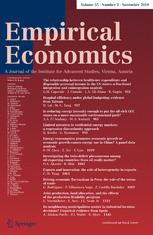
Bottom-up or Direct? Forecasting German GDP in a Data-rich Environment
This paper presents a method to conduct early estimates of GDP growth in Germany. We employ MIDAS regressions to circumvent the mixed frequency problem and use pooling techniques to summarize efficiently the information content of the various indicators. More specifically, we investigate whether it is better to disaggregate GDP (either via total value added of each sector or by the expenditure side) or whether a direct approach is more appropriate when it comes to forecasting GDP growth. Our approach combines a large set of monthly and quarterly coincident and leading indicators and takes into account the respective publication delay. In a simulated out-of-sample experiment we evaluate the different modelling strategies conditional on the given state of information and depending on the model averaging technique. The proposed approach is computationally simple and can be easily implemented as a nowcasting tool. Finally, this method also allows retracing the driving forces of the forecast and hence enables the interpretability of the forecast outcome.





